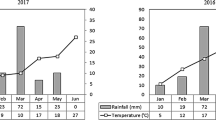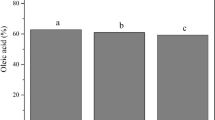Abstract
To investigate the effect of different planting dates and irrigation regimes on six canola cultivars, a 2-year (2014–2016) experiment was conducted at the Seed and Plant Improvement Institute of Karaj. The experiments were conducted as the factorial split-plot in a randomized complete block design including six canola cultivars (Gabriella, Brutus, Triangle, Marathon, Danube, and Natali), two irrigation regimes (fully irrigated and irrigation termination at the flowering stage) and two planting dates (October 1 and November 1). The results showed that irrigation termination from the flowering stage prevented the supply of required material for filling the seeds and the metabolism of the seed compounds and reduced the growth period of the seed. Therefore, a reduction was observed in the content of oleic and linoleic acids and proline. Also, water deficit stress caused an increase in the glucosinolate content of the seed. The response of canola cultivars was different in terms of fatty acids, so that the Natali cultivar had higher palmitic, oleic acids, and proline content compared to the other cultivars at both planting dates. Fully irrigated treatment and planting date of October 1 produced the highest amount of seed and oil yield (4659 and 2073 kg ha−1), palmitic acid (5.5%), and proline (22.7 μmol/g) content, and the lowest glucosinolate content (13.2 mg/g). Generally, the Natali cultivar and planting date of October 1 and the fully irrigated regime are highly recommended in the studied area regarding qualitative traits and yield of canola.
Zusammenfassung
Um die Auswirkungen verschiedener Pflanztermine und Bewässerungsregime auf sechs Rapssorten zu untersuchen, wurde ein zweijähriger Versuch (2014–2016) am Seed and Plant Improvement Institute in Karaj, Iran, durchgeführt. Die Experimente wurden als faktorielles Split-Plot-Design in einer randomisierten vollständigen Blockanlage mit sechs Rapssorten (Gabriella, Brutus, Triangle, Marathon, Danube und Natali), zwei Bewässerungsregimen (Vollbewässerung und Beendigung der Bewässerung in der Blütephase) und zwei Pflanzterminen (1. Oktober und 1. November) durchgeführt. Die Ergebnisse zeigten, dass die Beendigung der Bewässerung zum Zeitpunkt der Blüte die Versorgung mit den für die Samenfüllung und den Stoffwechsel der Samenbestandteile erforderlichen Stoffe beeinträchtigt und die Wachstumszeit der Samen verkürzt. So wurde eine Verringerung des Gehalts an Öl- und Linolsäure sowie Prolin beobachtet. Außerdem führte der Wasserdefizitstress zu einem Anstieg des Glucosinolatgehalts in den Samen. Die Rapssorten reagierten unterschiedlich im Hinblick auf die Fettsäuren, so wies die Sorte Natali im Vergleich zu den anderen Sorten bei beiden Pflanzterminen einen höheren Gehalt an Palmitinsäure, Ölsäuren und Prolin auf. Die Vollbewässerung und der Pflanztermin 1. Oktober erbrachten den höchsten Samen- und Ölertrag (4659 und 2073 kg ha−1), den höchsten Gehalt an Palmitinsäure (5,5 %) und Prolin (22,7 μmol/g) und den niedrigsten Glucosinolatgehalt (13,2 mg/g). Generell sind die Sorte Natali und der Pflanztermin 1. Oktober sowie die Vollbewässerung im untersuchten Gebiet hinsichtlich der qualitativen Merkmale und des Ertrags von Raps sehr zu empfehlen.





Similar content being viewed by others
References
Ahmadi M, Bahrani MJ (2009) Yield and yield components of rapeseed as influenced by water stress at different growth stages and nitrogen levels. J Agric Environ Sci 5:755–761
Ajithkumar IP, Panneerselvam R (2013) Osmolyte accumulation, photosynthetic pigment and growth of Setaria italica (L.) P. Beauv. under drought stress. Asian Pac J Reprod 2:220–224. https://doi.org/10.1016/S2305-0500(13)60151-7
Ashrafi E, Razmjoo K (2010) Effect of irrigation regimes on oil content and composition of safflower (Carthamus tinctorius L.) Cultivars. J Am Oil Chem Soc 87:499–506. https://doi.org/10.1007/s11746-009-1527-8
Association of Official Analytical Chemists (2003) Official methods of analysis of the AOAC. 963.22 7
Bashir MU, Akbar N, Iqbal A, Zaman H (2010) Effect of different sowing dates on yield and yield components of direct seeded coarse rice (Oryza sativa L). Pak J Agri Sci 47:361–365
Bates LS, Waldren RP, Teare ID (1973) Rapid determination of free proline for water-stress studies. Plant Soil 39:205–207. https://doi.org/10.1007/BF00018060
Bellaloui N, Mengistu A, Kassem MA (2013) Effects of genetics and environment on fatty acid stability in soybean seed. Food Nutr Sci 4:165
Bouchereau A, Clossais-Besnard N, Bensaoud A et al (1996) Water stress effects on rapeseed quality. Eur J Agron 5:19–30. https://doi.org/10.1016/S1161-0301(96)02005-9
Canvin DT (1965) The effect of temperature on the oil content and fatty acid composition of the oils from several oil seed crops. Can J Bot 43:63–69. https://doi.org/10.1139/b65-008
Chen C, Payne WA, Smiley RW, Stoltz MA (2003) Yield and water-use efficiency of eight wheat cultivars planted on seven dates in northeastern oregon. Agron J 95:836–843. https://doi.org/10.2134/agronj2003.8360
Djaman K, O’Neill M, Owen C et al (2018) Seed yield and water productivity of irrigated winter Canola (brassica napus L.) under semiarid climate and high elevation. Agronomy 8:90. https://doi.org/10.3390/agronomy8060090
Dogan M, Akgul A (2005) Fatty acid composition of some walnut ( Juglans regia L. ) cultivars from east Anatolia. Grasas Aceites 56:328–331. https://doi.org/10.3989/gya.2005.v56.i4.101
Enjalbert J‑N, Zheng S, Johnson JJ et al (2013) Brassicaceae germplasm diversity for agronomic and seed quality traits under drought stress. Ind Crops Prod 47:176–185. https://doi.org/10.1016/J.INDCROP.2013.02.037
Foladvand F, Khoshkhabar H, Naghdi N et al (2017) The effect of sowing date and nitrogen on yield, and essential oil of German chamomile. Scientia 19:85–92
Friedt W, Tu J, Fu T (2018) Academic and economic importance of brassica napus rapeseed. Springer, Cham, pp 1–20
Gan Y, Malhi SS, Brandt S et al (2007) Canola in the northern great plains. Agron J 99:1208. https://doi.org/10.2134/agronj2006.0296
Geren H, Ozdogan T, Simic A, Dzeletovic ZS (2020) Effect of different sowing dates on the grain yield and some yield characteristics of teff [Eragrostis teff (Zucc.) Trotter]. Turkish J F Crop 25:107–113. https://doi.org/10.17557/tjfc.831853
Hossein A, ShiraniRad AH, Bitarafan Z et al (2015) Effects of planting date on spring rapeseed (Brassica napus L.) cultivars under different irrigation regimes. Turkish J F Crop 19:153–157
Jensen CR, Mogensen VO, Mortensen G et al (1996) Seed glucosinolate, oil and protein contents of field-grown rape (Brassica napus L.) affected by soil drying and evaporative demand. F Crop Res 47:93–105. https://doi.org/10.1016/0378-4290(96)00026-3
Karami Chame S, Khalil-Tahmasbi B, ShahMahmoodi P et al (2016) Effects of salinity stress, salicylic acid and Pseudomonas on the physiological characteristics and yield of seed beans (Phaseolus vulgaris). Sci Agri 14:234–238
Kauser R, Athar HUR, Ashraf M (2006) Chlorophyll fluorescence: a potential indicator for rapid assessment of water stress tolerance in Canola (brassica napus L.). Pakistan J Bot 38(5 SPEC ISS):1501–1509
Krygsman P, Barrett A, Burk W, Todt H (2004) Simple methods for measuring total oil content by benchtop NMR. In: Oil Extraction and Analysis. pp 152–165
Laribi B, Bettaieb I, Kouki K et al (2009) Water deficit effects on caraway (Carum carvi L.) growth, essential oil and fatty acid composition. Ind Crops Prod 30:372–379. https://doi.org/10.1016/j.indcrop.2009.07.005
Lotfi R, Gharavi-Kouchebagh P, Khoshvaghti H (2015) Biochemical and physiological responses of Brassica napus plants to humic acid under water stress. Russ J Plant Physiol 62:480–486. https://doi.org/10.1134/S1021443715040123
Makkar H, Siddhuraju P, Becker K (2007) A laboratory manual on quantification of plant secondary metabolites. Human Press, Totowa
Moradi Aghdam A, Sayfzadeh S, Shirani Rad AH et al (2019) The assessment of water stress and delay cropping on quantitative and qualitative traits of rapeseed genotypes. Ind Crops Prod 131:160–165. https://doi.org/10.1016/j.indcrop.2019.01.051
Mumpton F (1999) La roca magica: uses of natural zeolites in agriculture and industry. Proc Natl Acad Sci 96:3463–3470
Nasiri A, Sam-Daliri M, Shirani-Rad A et al (2020) The Response of Growth and Yield of Canola Genotypes to Humic Acid Application in Different Plant Densities. Gesunde Pflanz 73:17–27. https://doi.org/10.1007/S10343-020-00524-4
Rahmani F, Sayfzadeh S, Jabbari H et al (2019) Alleviation of Drought Stress Effects on Safflower Yield by Foliar Application of Zinc. Int J Plant Prod 13:297–308. https://doi.org/10.1007/s42106-019-00055-7
Reiahisamani N, Esmaeili M, Khoshkholgh SNA et al (2018) Assessment of the oil content of the seed produced by Salicornia L., along with its ability to produce forage in saline soils. Genet Resour Crop Evol 65:1879–1891. https://doi.org/10.1007/s10722-018-0661-2
Safavi Fard N, Heidari SAH, Shirani Rad AH et al (2018) Effect of drought stress on qualitative characteristics of canola cultivars in winter cultivation. Ind Crops Prod 114:87–92. https://doi.org/10.1016/j.indcrop.2018.01.082
Shahsavari N (2019) Effects of zeolite and zinc on quality of Canola (brassica napus L.) under late season drought stress. Commun Soil Sci Plant Anal 50:1117–1122. https://doi.org/10.1080/00103624.2019.1604729
Sharma KD, Kuhad MS (2006) Influence of potassium level and soil moisture regime on biochemical metabolites of brassica species. Brassica J 8:71–74. https://doi.org/10.1007/s11356-015-5840-5
Shekari F, Soltaniband V, Javanmard A, Abbasi A (2016) The impact of drought stress at different stages of development on water relations, stomatal density and quality changes of rapeseed (Brassica napus L.). Iran Agric Res 34:81–90. https://doi.org/10.22099/IAR.2016.3452
Shirani Rad AH, Shahsavari N, Safavi Fard N (2017) Response of Canola advanced lines to delay plantings upon late season drought stress. J Sci Agric 1:307. https://doi.org/10.25081/jsa.2017.v1.837
ShiraniRad AH, Zandi P (2012) A comparison of fatty acid compounds in winter and spring rapeseed varieties Based of A joint project between CAAS and PUK View project Silicon availability to crops View project. Artic J Biol Res 3:1408–1414
Stefanoudaki E, Chartzoulakis K, Koutsaftakis A et al (2001) Effect of drought stress on qualitative characteristics of olive oil of cv Koroneiki. Grasas Y Aceites 52:202–206. https://doi.org/10.3989/gya.2001.v52.i3-4.358
Tatar O, Cakalogullari U, Tonk AF et al (2020) Effect of drought stress on yield and quality traits of common wheat during grain filling stage. Turk J F Crop 25:236–244. https://doi.org/10.17557/tjfc.834392
Tesfamariam EH, Annandale JG, Steyn JM (2010) Water stress effects on winter Canola growth and yield. Agron J 102:658. https://doi.org/10.2134/agronj2008.0043
Tohidi-Moghadam HR, Zahedi H, Ghooshchi F (2011) Oil quality of colza cultivars in response to water stress and superabsorbent polymer application. Pesqui Agropecuária Trop 41:579–586. https://doi.org/10.5216/pat.v41i4.13366
Zhao XJ, Song YY, Yue XL et al (2017) Effect of different potassium levels on the growth of bok choy under negative pressure. Sci Agric Sin 50:689–697
Author information
Authors and Affiliations
Corresponding author
Ethics declarations
Conflict of interest
A. Khalatbari, A. Shirani Rad, S.A. Valadabady, S. Sayfzadeh and H. Zakerin declare that they have no competing interests.
Rights and permissions
About this article
Cite this article
Khalatbari, A., Shirani Rad, A., Valadabady, S.A. et al. Yield Components and Fatty Acids Variation of Canola Cultivars Under Different Irrigation Regimes and Planting Dates. Gesunde Pflanzen 74, 17–27 (2022). https://doi.org/10.1007/s10343-021-00585-z
Received:
Accepted:
Published:
Issue Date:
DOI: https://doi.org/10.1007/s10343-021-00585-z




